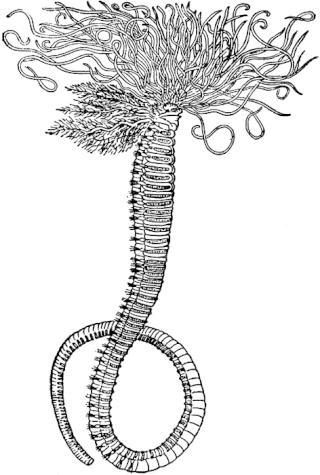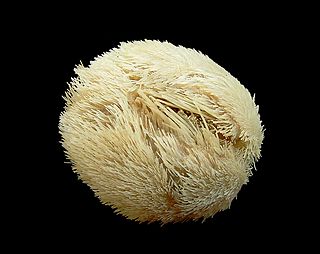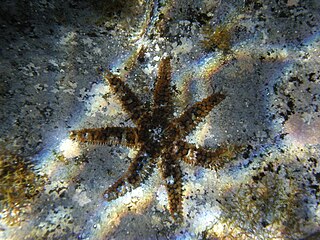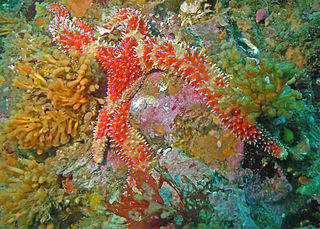
Asterias is a genus of the Asteriidae family of sea stars. It includes several of the best-known species of sea stars, including the (Atlantic) common starfish, Asterias rubens, and the northern Pacific seastar, Asterias amurensis. The genus contains a total of eight species in all. All species have five arms and are native to shallow oceanic areas of cold to temperate parts of the Holarctic. These starfish have planktonic larvae. Asterias amurensis is an invasive species in Australia and can in some years become a pest in the Japanese mariculture industry.

Umbrella octopuses are a group of pelagic octopuses. Umbrella octopuses are characterized by a web of skin between the arms, causing them to somewhat resemble an opened umbrella when the arms are spread.

Mediaster aequalis is a species of sea star in the family Goniasteridae. It is native to the west coast of North America, ranging from Alaska to California. It is found in various habitats including beaches during very low tides, and at depths down to about 500 m (1,600 ft). Also known as the vermilion sea star, it is the type species of the genus Mediaster and was first described in 1857 by the American zoologist William Stimpson.

The Asteriidae are a diverse family of Asteroidea in the order Forcipulatida. It is one of three families in the order Forcipulatida.

Histioteuthis reversa, commonly known as the reverse jewel squid or the elongate jewel squid, is a species of cock-eyed squid, so called because the eyes are dissimilar. It occurs at moderate depths in the Atlantic Ocean and the Mediterranean Sea. It is also known from the Indian Ocean.

Stichaster australis, the reef starfish, is a species of starfish found in the shallow waters of the rocky intertidal of New Zealand. Typically, the animal is endemic to the west coast shores of the North and South Islands, where wave action is increased. They do not usually inhabit ecosystems that have reduced wave action and calm conditions as they prefer a higher-energy environment. These marine invertebrates range in color from pink to purple, but can also be orange. They typically have eleven arms, but sometimes they may have either ten or twelve. As full-grown adults, they are 8 to 10 cm in diameter.

Amphitrite ornata or ornate worm, is a species of marine polychaete worm in the family Terebellidae.

Epiactis prolifera, the brooding, proliferating or small green anemone, is a species of marine invertebrate in the family Actiniidae. It is found in the north-eastern Pacific. It has a feature rare among animals in that all individuals start life as females but develop testes later in their lives to become hermaphrodites.

Echinocardium cordatum, also known as the common heart urchin or the sea potato, is a sea urchin in the family Loveniidae. It is found in sub-tidal regions in temperate seas throughout the world. It lives buried in the sandy sea floor.

Sagartia is a genus of sea anemones in the family Sagartiidae. The genus was first described by Philip Henry Gosse in 1855 and the image is his painting of several species found in British waters included in his book, A history of the British sea-anemones and corals.

Asexual reproduction in starfish takes place by fission or through autotomy of arms. In fission, the central disc breaks into two pieces and each portion then regenerates the missing parts. In autotomy, an arm is shed with part of the central disc attached, which continues to live independently as a "comet", eventually growing a new set of arms. Fragmentation occurs on star fishes.

Leptasterias is a genus of starfish in the family Asteriidae. Members of this genus are characterised by having six arms although five-armed specimens sometimes occur. L. muelleri is the type species. The taxonomy of the genus is confusing and Leptasterias hexactis seems to be a species complex. Some species brood their eggs.

Leptasterias hexactis is a species of starfish in the family Asteriidae, commonly known as the six-rayed star. It is found in the intertidal zone of the western seaboard of the United States. It is a predator and is unusual among starfish in that it broods its eggs and young.

Solaster stimpsoni, common names Stimpson's sun star, sun star, orange sun star, striped sunstar, and sun sea star, is a species of starfish in the family Solasteridae.

Solaster dawsoni, the morning sun star, is a species of starfish in the family Solasteridae. It is found on either side of the northern Pacific Ocean. It has two subspecies:

Evasterias troschelii is a species of starfish in the family Asteriidae. Its common names include the mottled star, false ochre sea star and Troschel's true star. It is found in Kamchatka and the north western coast of North America.
Stylasterias is a genus of starfish in the family Asteriidae. Stylasterias forreri, the velcro star, is the only species in the genus. It is found on the Pacific coast of Canada and the United States.

Orthasterias is a genus of sea stars in the family Asteriidae. Orthasterias koehleri, the rainbow star or red-banded sea star, is the only species in the genus. It is found in the North Pacific Ocean.

Coscinasterias muricata is a species of starfish in the family Asteriidae. It is a large 11-armed starfish and occurs in shallow waters in the temperate western Indo-Pacific region.
Sally F. Carson is a Canadian marine biologist and the director of the New Zealand Marine Studies Centre at the University of Otago.

















